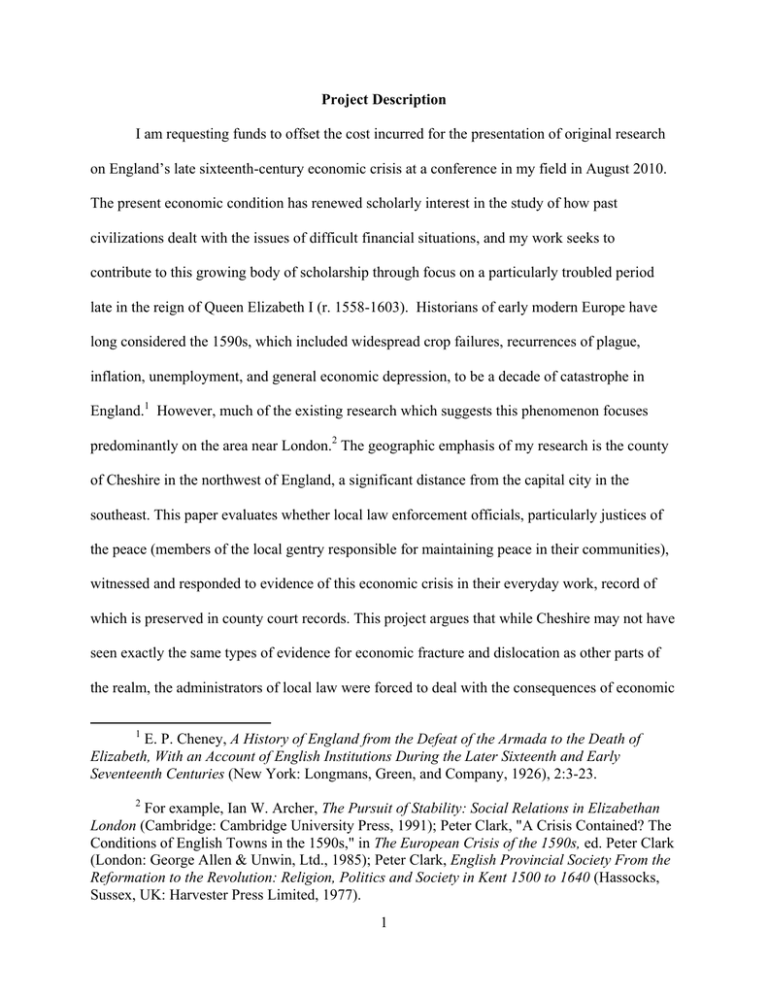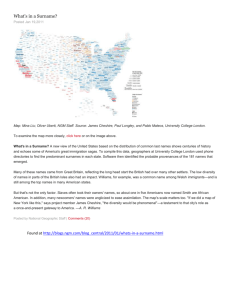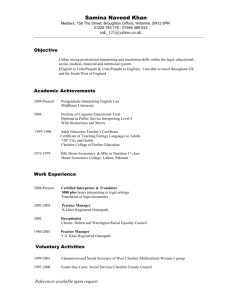I am requesting funds to offset the cost incurred for... on England’s late sixteenth-century economic crisis at a conference in... Project Description
advertisement

Project Description I am requesting funds to offset the cost incurred for the presentation of original research on England’s late sixteenth-century economic crisis at a conference in my field in August 2010. The present economic condition has renewed scholarly interest in the study of how past civilizations dealt with the issues of difficult financial situations, and my work seeks to contribute to this growing body of scholarship through focus on a particularly troubled period late in the reign of Queen Elizabeth I (r. 1558-1603). Historians of early modern Europe have long considered the 1590s, which included widespread crop failures, recurrences of plague, inflation, unemployment, and general economic depression, to be a decade of catastrophe in England.1 However, much of the existing research which suggests this phenomenon focuses predominantly on the area near London.2 The geographic emphasis of my research is the county of Cheshire in the northwest of England, a significant distance from the capital city in the southeast. This paper evaluates whether local law enforcement officials, particularly justices of the peace (members of the local gentry responsible for maintaining peace in their communities), witnessed and responded to evidence of this economic crisis in their everyday work, record of which is preserved in county court records. This project argues that while Cheshire may not have seen exactly the same types of evidence for economic fracture and dislocation as other parts of the realm, the administrators of local law were forced to deal with the consequences of economic 1 E. P. Cheney, A History of England from the Defeat of the Armada to the Death of Elizabeth, With an Account of English Institutions During the Later Sixteenth and Early Seventeenth Centuries (New York: Longmans, Green, and Company, 1926), 2:3-23. 2 For example, Ian W. Archer, The Pursuit of Stability: Social Relations in Elizabethan London (Cambridge: Cambridge University Press, 1991); Peter Clark, "A Crisis Contained? The Conditions of English Towns in the 1590s," in The European Crisis of the 1590s, ed. Peter Clark (London: George Allen & Unwin, Ltd., 1985); Peter Clark, English Provincial Society From the Reformation to the Revolution: Religion, Politics and Society in Kent 1500 to 1640 (Hassocks, Sussex, UK: Harvester Press Limited, 1977). 1 distress, particularly in the form of vagrancy, poor relief, and property offenses, such as theft, burglary, and the illegal taking of wildlife from others' property. The aforementioned criminal activities and acts of social welfare require further explanation to demonstrate how they indicate economic turmoil. Vagrancy, the crime of a beggar illegally wandering from town to town in search of work or charity, is emblematic of economic distress because these persons typically left their places of residence as a result of their inability to maintain a living there.3 Poor relief in early modern England entailed caring for the "deserving poor," a group which included maimed soldiers, widows and orphans, and those who for some reason beyond their control could not care for themselves.4 The necessity to relieve the poor implies the presence of poverty, a telltale sign of economic distress. Property offenses, such as larceny, also suggest economic turmoil, because the theft of goods is possibly the result of the inability to acquire supplies by legal means. The theft of necessities, such as clothing and foodstuffs, is particularly telling of a dire financial situation, because it appears that those convicted of this type of larceny were stealing in order to survive. The finding of multiple cases of each of these factors in my research supports a conclusion that Cheshire was not spared the economic crisis of the 1590s. The records used for my research were generated by the Quarter Sessions, which were meetings of the justices of the peace four times annually for the purpose of maintaining law and 3 This does not include the "idle" or "sturdy beggar," identified as a person who could work but chose not to do so. This type of offender is not telling of economic distress, because he was not viewed as a victim of circumstances. However, the records typically distinguish between the deserving and undeserving poor. A. L. Beier, Masterless Men: The Vagrancy Problem in England, 1560-1640 (New York: Methuen, 1985). 4 Paul Slack, Poverty and Policy in Tudor and Stuart England, Themes in British Social History (New York: Longman Inc., 1988), 62-7; Paul Slack, The English Poor Law, 1531-1782, New Studies in Economic and Social History (Cambridge: Cambridge University Press, The Economic History Society, 1990), 4. 2 order at the county level in early modern England. These records include petitions to the JPs from members of the community concerned about criminal activity in their towns as well as legal documents recorded by court clerks during the sessions pertaining to misdemeanors such as vagrancy, larceny, bastardy, assault, public drunkenness, and a variety of other offenses. These records are telling of the concerns of the community and the problems related to economic distress with which local law enforcement officials were forced to deal, many of which can be read as indicators of economic distress. My research contributes to the field of early modern English history by shedding light on the broader topics of economic and legal history. This project also helps to fill a void in the geographic and chronological framework of existing scholarship on this topic; the English northwest is an understudied region, and the majority of the existing scholarship from this area is from a time period beyond that which my paper covers.5 It also provides information on the operations of a past government during a period of economic crisis from which students of today can learn. Ultimately this study serves to elaborate on the achievements and frustrations of previous attempts at weathering crisis for the purpose of contributing to this renewed interest in economic history. Conference Information I presented this paper at the combined meeting of the Rocky Mountain Medieval and Renaissance Association and the Wooden O Symposium held August 9-11, 2010 (see proof of 5 Such works include: Joan Beck, Tudor Cheshire (Chester, UK: Cheshire Community Council, 1969); J. S. Morrill, Cheshire 1630-1660; County Government and Society During the English Revolution (London: Oxford University Press, 1974); C. B. Phillips and J. H. Smith, Lancashire and Cheshire from AD 1540 (New York: Longman, 1994). While Beck and Phillips and Smith's studies do incorporate the 1590s, the decade of crisis is not the focus of their studies. 3 acceptance and conference program attached). This is not a conference organized by and featuring only the work of graduate students (a limited number of graduate student papers were accepted for presentation) but a meeting of professional working historians and college professors, which allowed me to learn about the research of professional scholars in my field of study. Unlike multidisciplinary conferences at which I have presented, I was able to stay informed of the most recent scholarship in my field, much of which is pertinent to my own research. I was also fortunate to network with other researchers of medieval and early modern Europe, including the editor of a journal in my area of research, which will be beneficial as I prepare this work for publication. Presenting my paper at this conference provided me with the opportunity to get valuable feedback on my research concerning my methods and conclusions (including suggestions to consider more carefully the motivations for those who aided known criminals) which will be advantageous as I continue to develop this research into my M.A. thesis. Proposed Budget Airfare from Peoria, Illinois to Cedar City, Utah $725.50 Per Diem Meal Allowance (15 quarter days x $8.00 (out of state ) per quarter day $120.00 Conference Registration Fee $70.00 Total $915.50 Budget Narrative The cost of round trip airfare from Peoria, Illinois to Cedar City, Utah was $725.50 (see attached receipt). Flying was the more feasible travel option, because according to the WIU Business Services Travel website, one-way travel to Cedar City from Macomb is 1446 miles for 4 a total of 2892 miles; reimbursement at $.50 per mile would bring the total cost of driving to the conference to $1446. I departed Macomb for the conference at 4:30 am on August 8 and returned to Macomb at 10:00 pm on August 11, which is the equivalent of 15 quarter days. According to the WIU Business Services Travel website, out of state per diem meal reimbursement is $8.00 per quarter day, for a total allowance of $120. I did not accrue any lodging costs for the three nights I stayed at the conference, because I was able to room with another conference presenter. The conference registration fee was $70. This fee did not include any meals. The total cost of my attendance at the conference was $915.50. While this total surpasses the amount of the Graduate Student Research and Professional Development Grant, I plan to apply for funds from the College of Arts and Sciences and the Department of History to cover the remainder of the expenses. 5






